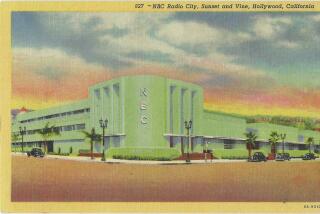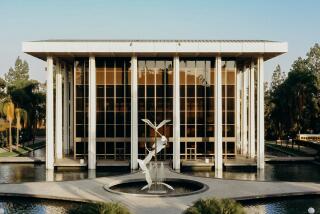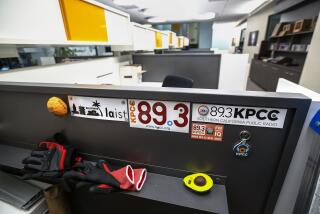Pasadena radio station KPCC embarks on new era
KPCC boasts “A Prairie Home Companion,” Larry Mantle’s popular “AirTalk” call-in show and an audience that has tripled in size in the last 10 years, turning the station into one of the country’s most-listened-to public radio outlets.
Coming next? A major expansion that its board of trustees hopes will make KPCC the hub of a regional constellation of public radio stations and a major source of news and information in Southern California.
On Saturday, KPCC will take the wraps off of a $24.5-million broadcast facility in Pasadena that houses 13 studios and control rooms, compared with one primary studio in the cramped quarters of the library at Pasadena City College that has been the station’s home since 1993.
Among the additional programming the new headquarters will afford is a local newsmagazine due to air this spring with Madeleine Brand. A year ago, Brand lost her job as co-host of the National Public Radio newsmagazine “Day to Day,” based in Los Angeles, when the network canceled the show and laid off about three dozen people, fallout from the economic downturn and a steep drop in corporate underwriting.
At a time when many public broadcasters are financially strapped -- reliant on shrinking government funds, meager college support, and subscription drives dreaded by listeners -- KPCC has thrived by tapping a board willing to write big checks and hit up their rich friends for contributions. Taking the lead are Gordon Crawford, managing director of the Capital Group, the Los Angeles investment fund manager, and Jarl Mohn, who built E! Entertainment Television.
Crawford, chairman of KPCC’s board, and Mohn, vice chairman, contributed about $4 million each to the five-year capital campaign for the new headquarters. They are also champions of a consolidation plan that has already put two additional stations under the umbrella of Southern California Public Radio, or SCPR, the nonprofit company that operates KPCC (89.3 FM), as well as KUOR-FM (89.1) in Redlands and KPCV-FM (90.3) in the Coachella Valley.
“Using these public airwaves for a public service that’s devoted to discussing the issues of the day is kind of critical to our democracy,” Crawford said. “Hopefully, the more we learn about each other, the better we’ll get along.”
Key for many donors was their desire to support KPCC’s news and talk programming and counter the polemics on talk radio, and the shrinking news operations elsewhere.
In the last 10 years, KPCC has won more than 230 regional and national journalism awards, and grown from a weekly audience of about 200,000 to nearly 600,000, second in size only to WNYC-FM in New York among news and information public radio stations and consistently ahead of KCRW-FM locally. (Classical music programmer KUSC-FM is the top rated public radio station in Southern California.)
SCPR has about 30 reporters, with bureaus in L.A., Orange County, the Inland Empire and Washington. (Times columnists Patt Morrison and David Lazarus and other staff members are frequent contributors to KPCC programming. Times reporters and editors appeared on KPCC programs about 150 times in 2009.)
“We are huge believers in the mission,” said Mohn, who early in his career worked in radio for 19 years with the on-air name Lee Masters. “There are increasingly fewer and fewer outlets for this kind of programming and content.”
About four-fifths of the money for the new building came directly from board members or their contacts, according to Bill Davis, president of SCPR. He cited generous early support from station trustees Charles Miller, the retired chief executive of Pasadena-based office products company Avery Dennison Corp., and philanthropist Adelaide Hixon, as well as donations from the James Irvine, W.M. Keck, Rose Hills and Ahmanson foundations.
In addition to the new offices and studios, known collectively as the Mohn Broadcast Center, the SCPR building houses the Crawford Family Forum, designed to host guest speakers, candidate debates and town hall meetings. In addition to the grand opening of the building Saturday, an open house will be held Sunday.
The ascent of KPCC started with a letter plucked from a trash can.
In 2000, KPCC was a low-budget, student-staffed station that mixed NPR’s news programming with a hodgepodge of music shows, including alternative, blues, big band and R&B. The annual budget was $300,000, with fundraising bringing in $200,000 and Pasadena City College on the hook for the rest, said James Kossler, college president from 1995 until his retirement in 2007.
Crawford said the station’s audience was so anemic that it was about to lose its Corporation for Public Broadcasting funding.
Minnesota Public Radio, the nonprofit group that ran its own network of public stations in the Midwest and produced programs, including “A Prairie Home Companion” and, later, “Marketplace,” wrote a letter to the college about taking over operation of the station.
“I’d love to say a big lightbulb went off over my head -- ‘this is our salvation’ -- but that isn’t exactly the way it happened,” Kossler said. “Public radio isn’t my background, so I didn’t even know some of the players.”
He forwarded the letter to KPCC, where someone swept it into the trash. That is, until then-general manager Cindy Young spotted it and fished it out. “This is a letter that needs to be replied to,” she told Kossler.
The college board of trustees eventually reached a deal with MPR, which later became American Public Media. A new offshoot, Southern California Public Radio, would run KPCC and assume all the costs, and in turn make an annual donation to the school’s scholarship fund. The college continues to hold the station’s operating license from the Federal Communications Commission.
“As I talked to them I thought, this is nothing but potential,” Kossler said. “I understood they were going to lift it to a higher level.”
Some listeners rebelled against the loss of favorite music shows. SCPR told them it wanted to expand the depth of public broadcasting and that “KPCC plans to become a pre-eminent full-time news and information station for the Los Angeles area.”
The first board meeting Crawford chaired was in 2003. He held it at the college so the other members could see the conditions. “Larry Mantle was working out of what amounted to a broom closet,” said Crawford.
In 2005, the company bought the building at 474 S. Raymond Ave., formerly home to architects and an art studio, and began refashioning the inside.
The new 35,000-square-foot building has ductwork crisscrossing the ceilings high above polished concrete floors, a clue to the industrial history of the neighborhood. More than one show at a time can fire up the microphones, one going live over the air, perhaps another online, still others recording pieces for future shows. Engineers can take feeds and mix programs in separate spaces rather than in a single room.
“People are actually able to focus on what they’re doing, instead of working in the cacophony of one room,” Davis said.
“The quality of our broadcasts will improve tremendously,” he predicted. “The number of on-air gaffes we had is a testament to how forgiving our audience is.”
The new facilities will let KPCC do more online programming, with podcasts, video streams, slide shows and other offerings.
Davis said other targeted major gifts might help SCPR with news gathering down the road -- $1 million for education or prison coverage, for example -- but the majority of its day-to-day budget still comes from individual donations, about $6 million last year.
Next up, Davis said , is to improve the station’s signal on the Westside and in Santa Clarita, and expand it north toward Santa Barbara and down to south Orange County.
“It’s not that we need to do more than what we’re doing now,” Davis said. “We need to do a lot more.”


